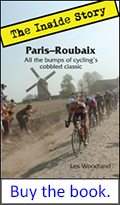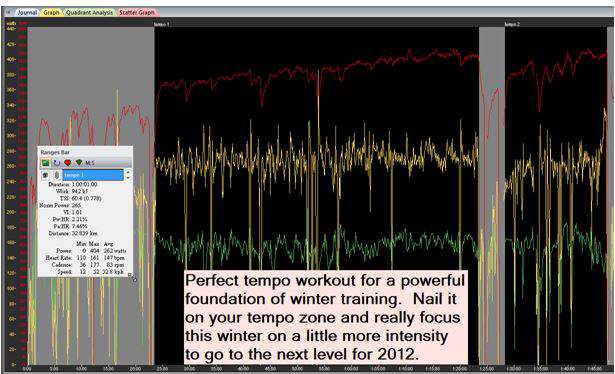

Workouts to Rebuild Your Power Foundation
by Hunter Allen, PCG Founder/CEO and Master Coach
Back to Training and Fitness index page

Les Woodland's book Paris-Roubaix: The Inside Story - All the bumps of cycling's cobbled classic is available as an audiobook here. For the print and Kindle eBook versions, just click on the Amazon link on the right.
Originally printed in Road Magazine
Hunter Allen writes:
I really don’t like the term “base training” because it produces images of long, slow distance training with watts at 60% of your threshold as you putter along. Too many athletes and coaches believe we have to do base training first before any other type of training can be started. Now, I’ll concede that if you’re a pro cyclist training for a huge season in Europe next year, then yes, you should be doing some serious base training right now; riding your bike four to six hours a day at endurance pace will help continue to develop your aerobic system and prevent you from peaking in January. But everyone else? Forget it. We don’t have the time to put in four to six hours a day at a slow pace, stopping at coffee shops along the way and enjoying the sights.
Most of us have only an hour or two each day to train, and we have to make the most of those hours and optimize our training for the highest ROI. If we spent those few hours riding at endurance pace, what would happen? We’d lose fitness and get slower. There’s a relationship between time and intensity that must be respected; the lower the intensity, the longer you should ride in order to stress that energy system. If you really want to improve your endurance system, riding at endurance pace for four or five hours is what you need to do. A two-hour ride won’t be long enough to create the necessary stress on the body to cause it to adapt and improve endurance.
So what is the correct intensity for your one or two hours of available time? The tempo zone, Level 3 on Dr. Coggan’s power level chart, 76-90% of your functional threshold power (FTP).

Riding at tempo pace is a challenge, but it won’t make you peak in January, either. By pushing yourself a little harder this winter in your shorter sessions (many of us are stuck on the trainer all winter, too), you’ll be able to stress your aerobic system appropriately enough to continue improving throughout the winter. Riding at the tempo level this winter is one of the keys to moving to the next level, as it creates the training stress you need as your power foundation, which is what I prefer to call winter and pre-season training; it doesn’t conjure up those dreaded thoughts of LSD training, and it focuses on the power side of the equation, since your winter goal is to increase your power at threshold. We all want to improve our overall aerobic fitness every season, since more fitness equals more fitness, and you’ll be riding faster than previously.
What types of workouts should you do this winter to make sure your power foundation is sufficiently challenged? Below are three suggestions that are perfect for both indoor and outdoor workouts, as each one can be adapted to either environment.
Workout One: Tempo with bursts and big gear efforts
This workout is designed to make you ride at a relatively high intensity, keeping your aerobic system taxed but not so much that you can’t do the big gear efforts afterward. The big gear intervals are done afterward since your muscles will already be fatigued from the tempo work, and you’ll have to summon more strength to do the work. The big gear efforts are there to help you create some additional muscular strength and translate any weight training you might be doing onto bike specific work.
Warm-Up (WU): 15 minutes.
Main Set (MS): Nail it for 60 minutes at 80-83% of your FTP, with 20 bursts (one every 3 minutes) for 10 seconds at 120% of your FTP. Ride easy for 10 minutes, then do 20 minutes at 80-83% of FTP and do big gear intervals: put it in your 53:13 at 50 rpm, and every 2 minutes (10 times total) slow down, stick it in the 53:13, stay seated, and use strength to push it to 90rpm. Once you reach 90 rpm, return to your tempo pace.
Cool down (CD): 10 minutes easy spinning.
Workout Two: Tempo and sweet spot intervals
This workout is designed to fatigue both your muscular endurance and cardiovascular system. By doing two longer, 30-minute intervals at your sweet spot (88-93% of FTP or upper tempo/lower threshold pace), you’ll really have to work and stay focused, but it will be doable. After you do the 30-minute efforts, you’ll have to ride at tempo for 45 minutes but at a lower level tempo pace, which again will be challenging as it stresses that muscular endurance system.
WU: 15 minutes steady.
MS: 5 x 1-minute fast pedals over 110rpm, with 1 minute of recovery between each. Then do 2 x 30 minutes at 88-93% of threshold, right in your sweet spot. Ride easy for 5 minutes after each. Finish with 45 minutes at 76-80% of FTP; nice tempo, but not hard.
CD: 15 minutes.
Workout Three: Solid tempo workout
This is your bread-and-butter winter workout. It’ll give you plenty of tempo work and will challenge your cardiovascular system. It’s sure to make you red in the face with some early hard work to wake you up.
WU: 15 minutes steady and smooth, getting the legs going.
MS: Do one 3-minute effort all out to get the carbon out of the legs, shooting for 115-120% of your FTP. Then do 5 x 1-minute fast pedaling intervals with 1 minute of rest after each. Ride for 20 minutes at endurance pace at a cadence faster by 5 rpm than your normal self-selected cadence (legs spinning just a little faster than they want to). Then do 60 minutes at tempo pace, not race pace; a notch below uncomfortable, but doable and at your normal cadence. (Tempo pace is 76-90% of FTP.)
CD: 10 minutes.

These workouts are just a few of the great variations on tempo that you can do this winter. The goal is to keep improving without peaking in January and to build your foundation so you’ll be ready for more intense threshold work later. These are for riders who don’t have four to six hours to ride each day. They’ll keep your fitness higher throughout the winter than normal, but you won’t have that far to go to peak for your key event in the spring. Give these workouts a shot; you’ll be pleasantly surprised with your new higher threshold this spring!
Back to Training and Fitness index page
.








